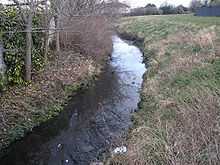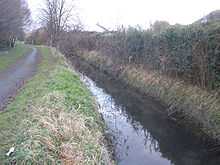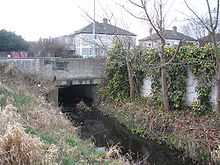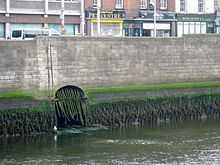River Poddle
| River Poddle An Poitéal | |
|---|---|
 River Poddle in Templeogue looking downstream | |
| Origin | Cookstown, Tallaght, County Dublin |
| Mouth | Discharges into River Liffey at Wellington Quay (Map) |
| River system | River Liffey |
| Left tributaries | Commons Water (Coombe Stream) |
The River Poddle (Irish: An Poitéal) is a river in County Dublin in Ireland. The city of Dublin is named after a "dark pool" (dubh linn, in Irish) that was once on its course. It rises in the Cookstown area, north of Tallaght, and flows into the River Liffey in the centre of Dublin.
Course
Origins
The Poddle begins as the Tymon River in the Cookstown area northwest of Tallaght village, near the site of Fettercairn House, and flows east, through Tymon North, and northeast, forming the northern border of Templeogue, towards Greenhills. Additional ponds were added to its course when Tymon Park was formed in the 1980s and 1990s. The river flows from Greenhills into Kimmage, where it used to receive an artificial stream from the direction of Templeogue. This, the City Watercourse, carried water from the River Dodder extracted at Balrothery Weir.
City Watercourse
The Poddle's modest volume was increased for over 700 years by the significant addition of water diverted from the River Dodder at the great weir at Balrothery, north of Firhouse, and carried by the three-kilometre first section of the City Watercourse. The ancient watercourse was, without explanation, disrupted in recent times by development allowed by Dublin County Council, and it no longer operates.
The Tongue
The river is split at "The Tongue" at Mount Argus monastery in Harold's Cross, with one third of the flow forming the second section of the City Watercourse, heading for Crumlin Road and Dolphin's Barn, and two thirds continuing along a form of the original river bed. In the 1990s, changes were made in the Kimmage area, including the addition of a large fountain to the river.
Lower course
The line of the two Poddle flows later recombine and pass under much of the south city centre in a culvert. The final stages of the river's flow are complex, with related waters separating and joining. Linked flows include the Tenter Water, and the river is joined by the Commons Water from the Coombe, and ultimately Crumlin. The present main course is itself a diversion, the Abbey Stream, of the original course, which ran further east.
Nowadays, much of the lower course of the Poddle is in a large brick tunnel under the city streets and Dublin Castle, and while access is restricted, it is walkable.
The confluence of the Poddle and the Liffey is visible at low tide at a grated opening in the Liffey walls at Wellington Quay (picture below).
Dubh Linn and the origins of "Dublin"
A large, dark pool once existed at the confluence of the Rivers Poddle and Liffey; this pool was described in Irish as dubh linn, which means dark pool or black pool. The city name, Dublin, is an anglicisation of this Irish phrase. This historic pool existed under the present site of the Coach House and Castle Gardens of Dublin Castle.
During the ninth century, Vikings established themselves as Kings of Dublin, and based their settlement around the confluence of the two rivers, upstream from the Stayne long-stone.
History
The Poddle was known colloquially as the river Salach, or "dirty river" in Irish. A variation of this name is used in the old children's song The River Saile (or Weile Weile Waila), famously performed by The Dubliners.
In 1592, Red Hugh O'Donnell and Art O'Neill escaped from Dublin Castle through a drain into the Poddle which runs under the castle from Ship Street gate to the Chapel Royal and the Undercroft. The Poddle was later used to provide a water defence for the south wall of the castle.
For centuries the Poddle, progressively culverted, caused regular flooding and constant dampness in many buildings in the Blackpitts to St. Patrick's Street areas, including St. Patrick's Cathedral. For much of this time, a special public body, the Poddle Commission, operated, working to manage this, and with the power to raise a special tax to support its work. During a major reconstruction of the cathedral in the nineteenth century, the graves of Dean Jonathan Swift and Stella were moved to their present location, due to the problem of the Poddle.
Water supply
The river provided an early source of water for the city as the Liffey was tidal within the city area, and undrinkable, and the other major south-side water, the Camac, was too far from the main settlement (although there may have been a channel diverting some flow from it), while the Stayne River was too small. By the 13th century the water supply was inadequate and a deal was made, in 1244/1245, with the Priory of St. Thomas to divert water from the Dodder at the weir at Balrothery near Firhouse to the Poddle, to provide the greater part of the water flow. As mentioned, this connection was allowed to dry out in the late 20th century, and only a tiny part still carries water, though ample evidence of the watercourse can be seen: the sluices and channel on the north side of the Firhouse weir still stand.
Pictures
 River Poddle upstream of Templeville Road, prior to flowing under it. |
 River Poddle emerging from under Templeville Road. |
 River Poddle flowing downstream from Templeville Road towards Whitehall Park. |
 Confluence of the River Poddle and River Liffey at low tide at Wellington Quay, Dublin. |
See also
- The Back of the Pipes, Dublin
- Rivers of Ireland
- List of rivers in County Dublin
References
Bibliography
- Doyle, Joseph W. (2012) [2008]. Ten Dozen Waters: The Rivers and Streams of County Dublin (5th edition). Dublin, Ireland: Rath Eanna Research. pp. i–iv, 1–50 + photos and map. ISBN 978-0-9566363-4-8.
- Sweeney, Clair L. (1991). The Rivers of Dublin. Dublin, Ireland: Dublin Corporation. pp. 1–115, inc. many maps. ISBN 0-9505301-4-X.
External links
| Wikimedia Commons has media related to River Poddle. |
- A history of Dublins' water supply
- Details of stones found in Poddle Culvert in 1901
- Details of finds near Poddle culvert
- Dublin Castle History - mention of Poddle
- Tymon Regional Park - mentions where Poddle rises
- Pictures and short video of the Abbey stream, River Poddle, in Blackpitts, Dublin
- Urban Tales program on RTE Tracks the history of the Poddle
Coordinates: 53°18′14″N 6°19′44″W / 53.303916°N 6.328931°W
| ||||||||||||||||||||||||||||||